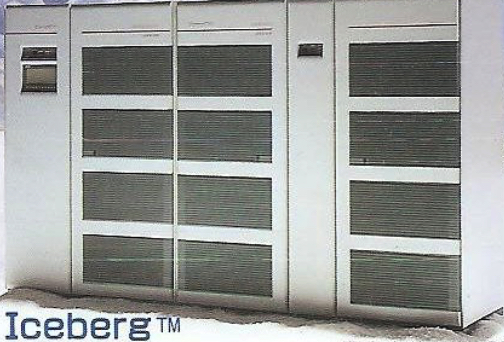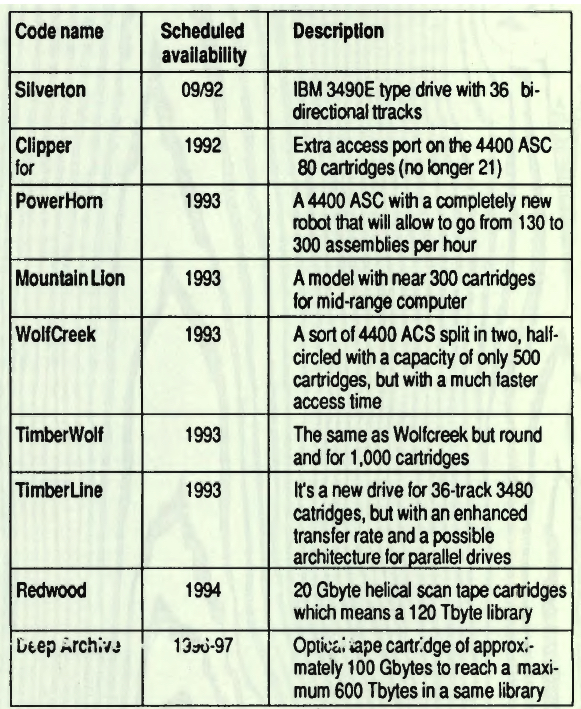History (1992): StorageTek Iceberg
"World's most advanced disk array storage subsystem"
By Jean Jacques Maleval | May 13, 2020 at 2:17 pmStorage Technology Corp. (Louisville, CO) is not the first company to launch a new RAID, but the importance of its announcement could boost a rising market.
On January 28, it unveiled a long-awaited Iceberg RAID subsystem that it qualifies as the “world’s most advanced disk array storage subsystem.“

The US company is expecting a lot from this new product. It invested $145 million since November 1987 when, for the first time, Ryal R. Poppa, chairman, president and CEO of the company, gathered a small team that was going to be in charge of developing a new RAID. A code name had to be found for the product, it was so cold in the room that someone mentioned Iceberg, and the name was adopted for the final product.
Before its announcement, almost 1,200 customers and prospects in the world were invited to see the product in StorageTek’s HQ, and a Falcon jet was specially leased for this purpose.
Obviously the mainframe peripheral manufacturer couldn’t live forever on its automatic 3480 tape cartridge libraries that helped him come out of Chapter 11.
Is Iceberg going to be the new product that will help StorageTek rebound a second time?
“Disk failures will no longer be crippling for business”
StorageTek, who manufactured compatible 3380 drives, had obviously shown it didn’t want to get involved in 3390 technology to directly get on with RAID technology.
On a technical point of view, the Iceberg 9200 is quite remarkable. The idea at the beginning was to replace large 14-inch 3380 or 10.8-inch 3390 drives as well as their controllers by a stack of 5.25-inch disks in a RAID architecture to add the advantages of fault tolerance.
“A global company will have access to its mission-critical data virtually 24 hours a day, 7 days a week. When a disk in an Iceberg subsystem fails, the subsystem will heal itself while continuing to work at a near-peak efficiency. This means that disk failures will no longer be crippling for business,” said Poppa.
High prices to begin
List prices range from approximately $1.3 million in the US for a minimum configuration to more than $3.6 million for a maximum one. The minimum is 64MB of cache and 32 Hewlett-Packard 5.25-inch disks with 1.45GBs each to provide 100GB of compressed storage capacity. The maximum includes 512MB of cache and 128 disks for 400GB. Prices include a disk array controller, 1 to 4 disk array units and software.
Claude Fer, president of StorageTek France, commented: “These prices are 5% below those of IBM for an equal capacity in the minimum configuration and 40% less in a maximum one.”
Todger Anderson, manager of the Westcore Midco Fund, stated in Barron’s: “With margins approaching 60%, we expect an explosion in their (StorageTek’s) earnings.”
The Colorado company is not counting on the prices but more on Iceberg’s advantages and its higher performances to compatible configurations. Let’s mention the excellent relations between HP and StorageTek since the companies are also discussing an agreement for StorageTek to supply HP with next gen magneto-resistive heads for tape drives.
Improved RAID-5
The maximum 400GB fit in a 4 square-meter floor space. Compared with 3390s, StorageTek also puts ahead the fact that Iceberg takes up 3 times less space, uses 2 times less kilowatts and dissipates 2 times less calories.
StorageTek doesn’t exactly mention Iceberg’s RAID level but names its own development XSA (eXtended Storage Architecture) that can be qualified as an improved RAID-5. Data parity checking is distributed across the entire disk array. It features dual-redundance disk arrays and employs traditional Reed-Solomon parity technics to provide 2 levels of data protection to recreate unreadable data on any 1 or 2 failed devices in a disk array on the fly. Iceberg is composed by a minimum of 2 arrays and up to 8. Each one has 15 disks plus an extra emergency disk to automatically replace a failing one.
The microcode of the IBM controller is replaced by a software. The entire RAID checking instructions are in programs that total close to 200,000 lines in C language, not on cards, which means that 8 powerful processors are required, a total of 100MIPS.
StorageTek doesn’t give any clear comparisons with 3390s in terms of access times. The only thing mentioned is that “under TSO, for a same response time, you reach more than 1,300 IO/s, 2 times more than with a 3390 model III.”
MVS and VM OSs permit only 1 I/O operation to an online storage subsystem volume at a time. XSA supports 12 independent and concurrent channel operations, 4 of which may be data transfers.
3380/3390s and 5.25-inch drives don’t have the same length of track. On Iceberg, based on the FBA (Fixed-Block Architecture), the translation is done within the controller. At the heart of XSA is a mapping capability which presents an IBM 3990 interface to the host, user and systems programmer. Tables of pointers in the controller provide dynamic mapping between the functional configuration which the host sees and the physical devices which comprises the Iceberg subsystem.
One disadvantage of RAID-5s is the delay for a writing order that sometimes requires 4 IO/s from the controller when the disk has to be overwritten. StorageTek says to have avoided this by always writing on a space where no useful data is stored, with an automatic data restructuration on the disks when the host computer is not accessing disks.
To improve the overall reliability, cooling systems, power supplies, emergency batteries, cables, electronic cards, data patches and even the operator panel have a backup.
Data compression required
All data is compressed before it is written on a disk and decompressed on the way back before it is sent to the host computer. StorageTek uses a proprietary algorithm based on Lempel-Ziv technology processed with ASICs specially developed and not IBM’s IDRC for its 3490 cartridges.
This means that, later, when Iceberg will be directly attached to the ACS 4400 library – which shouldn’t be before next year-, data from the computer will first be compressed to be placed on the disk, then decompressed before it is eventually recompressed with another algorithm before it is stored on magnetic tape cartridges. This represents a tedious operation. Iceberg’s direct connection to a library will have the advantage of enabling users to backup at any time of the day, each time the mainframe doesn’t need disks.
StorageTek didn’t give the compression level ratio of its algorithms but when you figure out the manufacturer’s announcement, 100GB on 2 arrays of 16 disks with formatted 1.45GB, and if you leave out the emergency disk and 2 disks for parity, you reach a ratio close to 3, which is rather an average high level. Since this ratio depends on the type of data, an Iceberg user cannot know in advance the total capacity available and especially since he cannot cancel the compression.
Users will still have to wait for an extra device named XSA/Snapshot Copy, quite interesting, which permits Iceberg, as predetermined times, to take “a picture of the pointers, or the “roadmap” to the data.
Because Iceberg will not overwrite the original, and only the pointer will be copied in a minimum of time, in the event of a failure, data will be reconstructed only back to the snapshot and in a few seconds.
Sell out
The day Iceberg was unveiled, StorageTek “announced commitments from more than 140 customers, with two-thirds in the US, to purchase subsystems with a total value of more than $150 million.”
Obviously most of them chose minimum configurations, just to try. The 1992 production could nevertheless be completely sold, and StorageTek plans to ship 1,000 to 1,200 extra systems next year.
Iceberg will be practically available in beta test by 2Q92 and in volume production by 3Q92.
StorageTek could be the blasting cap for a RAID market still slim. According to Peripheral Research, disk arrays based systems only represented 2.1% of the entire disk drive system market in 1991, but shipments of arrays will climb by more than 20% a year until 1994.
Until now, EMC Corp. (Hopkinton, MA) was the only RAID player in the 3480/3490 compatible market, based on 5.25-inch disks. Its latest model, Symmetrix 4832, supports up to 32 HDDs, for 40GB, which is far below StorageTek’s offer. EMC says to have installed 375 Symmetrix worldwide which represented $90 million sales.
According to US experts, IBM shouldn’t offer anything before next year. Its only proposal today is the 9570, a RAID-3 for the scientific market. It would be quite amazing if Big Blue, for who mainframe HDDs account in a large part of its revenues and who has always been ahead in this segment, repeats the same mistake as with the automatic cartridge libraries market.
We can’t see IBM loosing a high-end disk drive market close to $12 billion, where it holds 70% to 75% in front of Hitachi with 10%, StorageTek with 5% and Amdahl Fujitsi with 4%, according to figures from Sam Taub, marketing director of StorageTek France.
But Big Blue’s problem is less technical than marketing. Isn’t it too soon to launch a new gen after the 3390 announcement that only was two years ago?
Following developments
StorageTek is going to produce various developments of Iceberg. In 2H92, Alpine Storage Manager will be available, a RAID subsystem compatible with IBM 9335/9336, and in 1H92 the Snowmass Disk Subsystem which will consist of 5.25-inch rack-mounted drives compatible with IBM’s 9336 drives. These products will be distributed by XL/Datacomp (Hinsdale, IL), StorageTek’s new subsidiary specialized in AS/400s.
Mid-90, StorageTek announced it will market a RAID from Array Technology, founded by Tandem, a spin-off of Seagate and finally later bought by Tandem. This RAID+ was a 9.12 to 19.2GB unit using 5.25-inch drives and was supposed to complement Iceberg in the low-end line of what StorageTek RAID planned by itself. Alpine is probably originated from Array Technology’s product.
StorageTek is actually looking for a site in Europe to set up a plant that would be a second manufacturing source for all its products, cartridge libraries and Iceberg. The choice should be made in the next 12 months.
10 software firms plan Iceberg support
Ten ISVs have stated intentions to provide transparent support for Iceberg: Boole & Babbage, Computer Associates International, Goal Systems International, Innovation Data Processing, Landmark Systems, Legent, Software AG of North America, Sterling Software, Syncsort, and Systems Center. Five vendors have said they intend to develop enhanced software: Boole & Babbage, Innovation Data Processing, Landmark Systems, Sterling Software, and Syncsort.
Future announcements

This article is an abstract of news published on the former paper version of Computer Data Storage Newsletter on issue ≠49, published on February 1992.













 Subscribe to our free daily newsletter
Subscribe to our free daily newsletter

